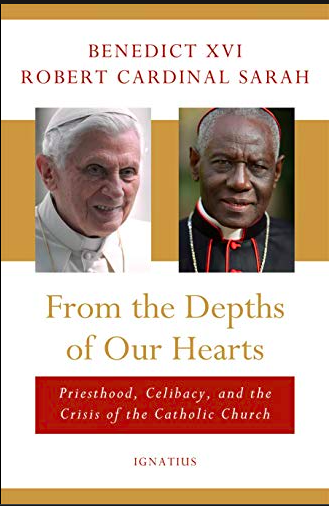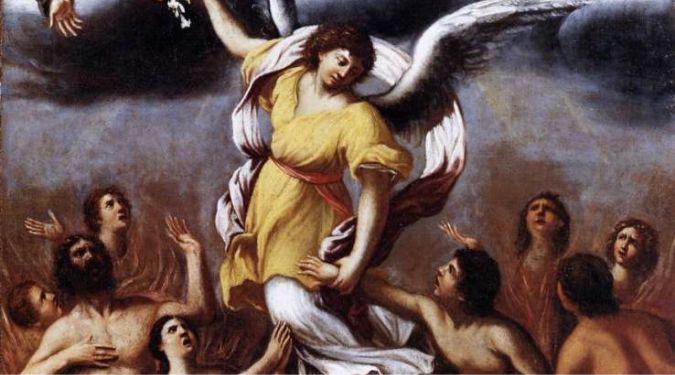Why does the Catholic Church require most of its priests to live a celibate life? While most of the Eastern Catholic churches allow married men to be ordained, priests of the Latin Rite must be celibate.
In this post I’ll present a few thoughts to ponder from Pope Benedict XVI and Cardinal Robert Sarah on this subject from their book “From the Depths of Our Hearts: Priesthood, Celibacy, and the Crisis of the Catholic Church.” Each man contributed a substantial essay for the book. This will not be an exhaustive treatment of their words on the subject in any way, but rather just some food for thought.

Into the Holy of Holies
Pope Benedict sets out the basis for a Christological interpretation of the Old Testament in the first part of his essay. He says,
“At the foundation of the serious situation in which the priesthood finds itself today, we find a methodological flaw in the reception of Scripture as Word of God.”
(Sarah & Pope Benedict XVI, 2020, 25)
This “methodological flaw” is the failure to interpret the Old Testament, particularly the Old Testament priesthood, in the light of Christ. He says of the Catholic priesthood:
One would be tempted to see in it a relapse into a cultic priesthood that was outmoded and should be rejected. Quite the contrary, it is precisely the step forward of the New Covenant, which takes up into itself and at the same time transforms the Old Covenant by elevating it to the height of Jesus Christ.
(Sarah & Pope Benedict XVI, 2020, 50)
One scriptural verse put forward by the Pope is Psalm 16:5-6, used in the Rite of Ordination prior to the second Vatican Council:
“The Lord is my chosen portion and my cup; thou holdest my lot. The lines have fallen for me in pleasant places; yea, I have a goodly heritage.”
Psalm 16:5-6
Each clan and family of Israel was given a portion or plot of land in the Promised Land, which would be handed down to succeeding generations (Num 34), but the priests of Israel who sang this psalm in the temple would have remembered God’s word to Aaron in the eighteenth chapter of the Book of Numbers:
“And the Lord said to Aaron, “You shall have no inheritance in their land, neither shall you have any portion among them; I am your portion and your inheritance among the people of Israel.”
Numbers 18:20
Aaron and his sons, the priests of Israel, would have no such portion and were asked to trust in God completely, reminding us of that passage about the apostles in the fifth chapter of the Gospel of Luke:
“And when they had brought their boats to land, they left everything and followed him.”
Luke 5:11
But so far we’re talking about total dependence upon God, and not celibacy. Let’s get to that now.
The Pope recalls the story of David and his hungry men, on an expedition in Nob, when David asked Ahim′elech the priest if they could eat the bread in the sanctuary there:
And the priest answered David, “I have no common bread at hand, but there is holy bread; if only the young men have kept themselves from women.” And David answered the priest, “Of a truth women have been kept from us as always when I go on an expedition; the vessels of the young men are holy, even when it is a common journey; how much more today will their vessels be holy?”
1 Samuel 21:4-5
So David, not even a priest, was expected to abstain from sex before approaching the holy things. That’s because Israel’s priests were expected to abstain from sex prior to their duty in the Tent of Meeting or in the Temple. We see this in the fifteenth chapter of Leviticus, where nobody, especially the priests could approach the Tent of Meeting if they had sex that day.
While Leviticus expresses this in terms of ritual impurity, it can be argued that a demand for prayerful focus and attention were the motivation. God asked the entire nation of Israel to abstain from sexual relation for three days prior to the giving the Law on Mt. Sinai. (Ex. 19:15)
And then there are St. Paul’s words in the seventh chapter of his first letter to the Corinthians:
The unmarried man is anxious about the affairs of the Lord, how to please the Lord; but the married man is anxious about worldly affairs, how to please his wife, and his interests are divided.
I Corinthians 7:32b-34a
So the priests of Israel had to abstain for a time before they served in the sanctuary. This did not prevent them from being married however, since they did not serve every day. The Church, on the other hand, did start to offer the sacrifice or oblation of the Eucharist on a daily basis long before St. Augustine wrote his Confessions late in the 4th century. Speaking of the prayers of his mother St. Monica in that book, he said that she was “so gracious and attentive to Your saints, not permitting one day to pass without oblation at Your altar, twice a day, at morning and even-tide, coming to Your church without intermission.” (St. Augustine, Confessions, Book V, Chapter 9) (Church Fathers, n.d., 2159)
This daily offering of the Eucharist was a significant factor in the Church’s adoption of the discipline of celibacy for its priests, as periodic continence was for the priests of the Old Testament.
Pope Benedict says:
“From now on, the cultic act proceeds by way of an offering of the totality of one’s life in love. The priesthood of Jesus Christ causes us to enter into a life that consists of becoming one with him and renouncing all that belongs only to us. For priests, this is the foundation of the necessity of celibacy but also of liturgical prayer, meditation on the Word of God, and the renunciation of material goods.”
(Sarah & Pope Benedict XVI, 2020, 26)
The Bridegroom
Cardinal Sarah, in his essay, reminds us of the biblical type of the Bridegroom:
“No more shall you be called “Forsaken,” nor your land called “Desolate,”
But you shall be called “My Delight is in her,” and your land “Espoused.”
For the Lord delights in you, and your land shall be espoused. For as a young man marries a virgin, your Builder shall marry you; And as a bridegroom rejoices in his bride so shall your God rejoice in you.”
Isaiah 62:4-5
The Church recognizes Jesus as the Bridegroom in Isaiah’s messianic prophecy. Jesus calls himself the Bridegroom when the disciples of John asked him why his disciples did not fast:
Then the disciples of John came to him, saying, “Why do we and the Pharisees fast, but your disciples do not fast?” And Jesus said to them, “Can the wedding guests mourn as long as the bridegroom is with them? The days will come when the bridegroom is taken away from them, and then they will fast.
Matthew 9:14-15
And St. John prophesied too in the Book of Revelation:
Let us rejoice and exult and give him the glory, for the marriage of the Lamb has come, and his Bride has made herself ready;
Revelation 19:7
And I saw the holy city, new Jerusalem, coming down out of heaven from God, prepared as a bride adorned for her husband.
Revelation 21:2
When reflecting upon priestly celibacy we cannot take our eyes off of Jesus, the Church’s Bridegroom, as priests are configured to Christ and act in persona Christi in the Church – in the person of Christ. Cardinal Sarah constantly makes reference to the image of the Bridegroom in his discussion of celibacy. He quotes Pope St. John Paul II:
“The Church, as the spouse of Jesus Christ, wishes to be loved by the priest in the total and exclusive manner in which Jesus Christ her head and spouse loved her. Priestly celibacy, then, is the gift of self in and with Christ to his Church and expresses the priest’s service to the Church in and with the Lord.”
St. Pope John Paul II, Apostolic Exhortation Pastores Dabo Vobis 29
Cardinal Sarah says,
“This statement by Saint John Paul II is of capital importance. It holds up celibacy as a need of the Church. The Church needs men who love with the very love of Christ the Bridegroom…You can say that the Church would no longer understand herself if she were no longer loved totally by celibate priests who sacramentally represent Christ the Bridegroom…“The priest’s capacity for spousal love is entirely given to and reserved for the Church. The logic of the priesthood excludes any “other spouse” than the Church.”
(Sarah & Pope Benedict XVI, 2020, 82-85)
And in another place,
“The priest is capable of being a husband and a father according to the flesh, but by his celibacy he renounces that form of human flourishing. Out of love, he chooses to deprive himself of it in order to live as the exclusive husband of the Church.”
(Sarah & Pope Benedict XVI, 2020, 137)
This idea of the priest, configured to Jesus Christ and being married to the Church is an ancient one, and precedes the first Lateran Council of 1123 AD, which is typically deemed to have been the Church council that universally imposed celibacy upon its priests.
Says Cardinal Sarah,
“Some will tell me that priestly celibacy is only a discipline that was imposed at a late date by the Latin Church on her clerics. I have read such statements, which are repeated in many newspapers. Historical honesty obliges me to declare that they are false. Serious historians know that from the fourth century on, the councils recall the necessity of continence for priests. We must be precise. Many married men were ordained priests during the first millennium. But from the day of their ordination on, they were obliged to abstain from sexual relations with their wives.”
(Sarah & Pope Benedict XVI, 2020, 76-77)
Of the decision of the first Lateran Council Cardinal Sarah says, “The fact that such a demanding decision aroused no opposition proves that the law of clerical continence was not something new.“ (Sarah & Pope Benedict XVI, 2020, 78)
Cardinal Sarah mentions the Council of Elvira, a meeting of the bishops of the Iberian peninsula held in the first six years of the 4th century. From Canon 27 from that Council:
“A bishop, or any priest at all, may have with him only a sister or a virgin daughter dedicated to God; it is decided that he by no means have a stranger.”
(Denzinger, 2002, 25)
And from Canon 33:
“It is decided that marriage be altogether prohibited to bishops, priests, and deacons, or to all clerics placed in the ministry, and that they keep away from their wives and not beget children; whoever does this, shall be deprived of the honor of the clerical office.”
(Denzinger, 2002, 25)
This is also confirmed by Pope St. Siricius in a letter to Himerius, Bishop of Terracina,a city near Rome in 385 AD, on the Celibacy of the Clergy. (Denzinger, 2002, 38)
Lastly, St. Ambrose, bishop of Milan late in the 4th century confirmed this in his “on the Duties of the Clergy”, Book I, Chapter 50 . (Church Fathers, n.d., 512)
We see then, that the Church appropriated the abstinence of the sacrificing priests of Israel as types and has seen priests of the New Covenant as Bridegrooms of the Church as early as the first part of the 4th century. A rush to undo priestly celibacy could be motivated by an abandonment of a christological interpretation of the Old Testament.
References
- Church Fathers. (n.d.). The Complete Works of the Church Fathers (P. Schaff, Ed.). Public Domain.
- Denzinger, H. (2002). The Sources of Catholic Dogma (R. J. Deferrari, Trans.). Loreto Publications.
- Pastores Dabo Vobis (March 15, 1992) | John Paul II. (n.d.). vatican.va. Retrieved June 23, 2022, from https://www.vatican.va/content/john-paul-ii/en/apost_exhortations/documents/hf_jp-ii_exh_25031992_pastores-dabo-vobis.html
- Sarah, R., & Pope Benedict XVI. (2020). From the Depths of Our Hearts: Priesthood, Celibacy, and the Crisis of the Catholic Church. Ignatius Press.






Another good read and